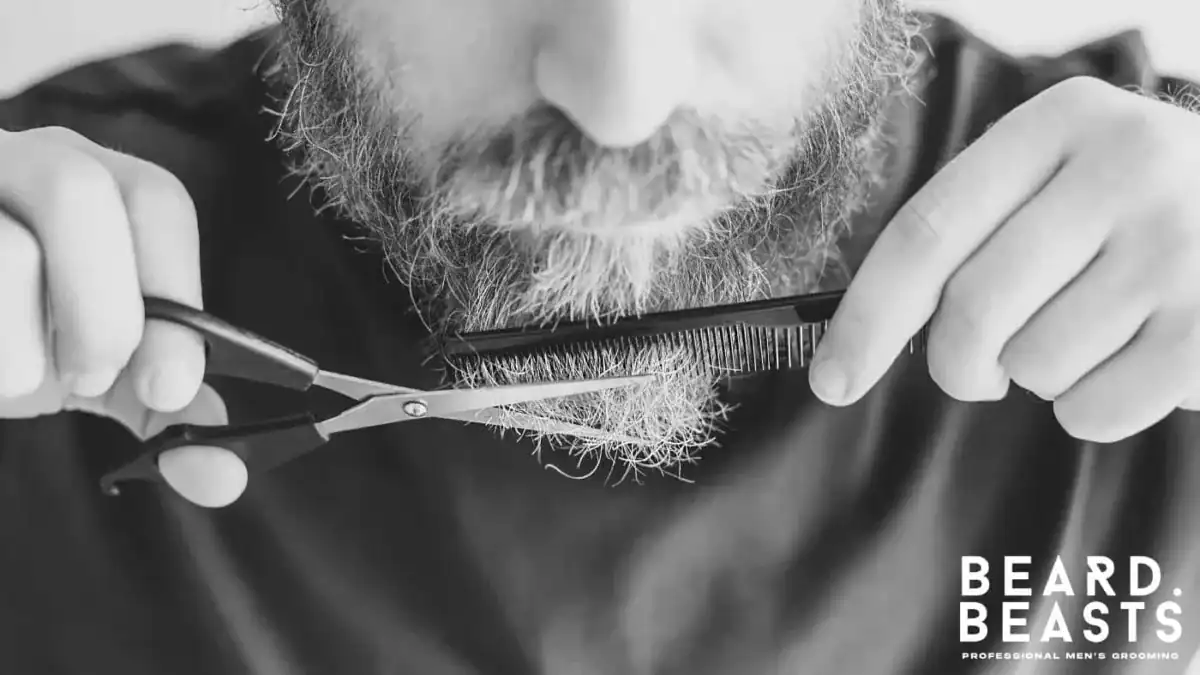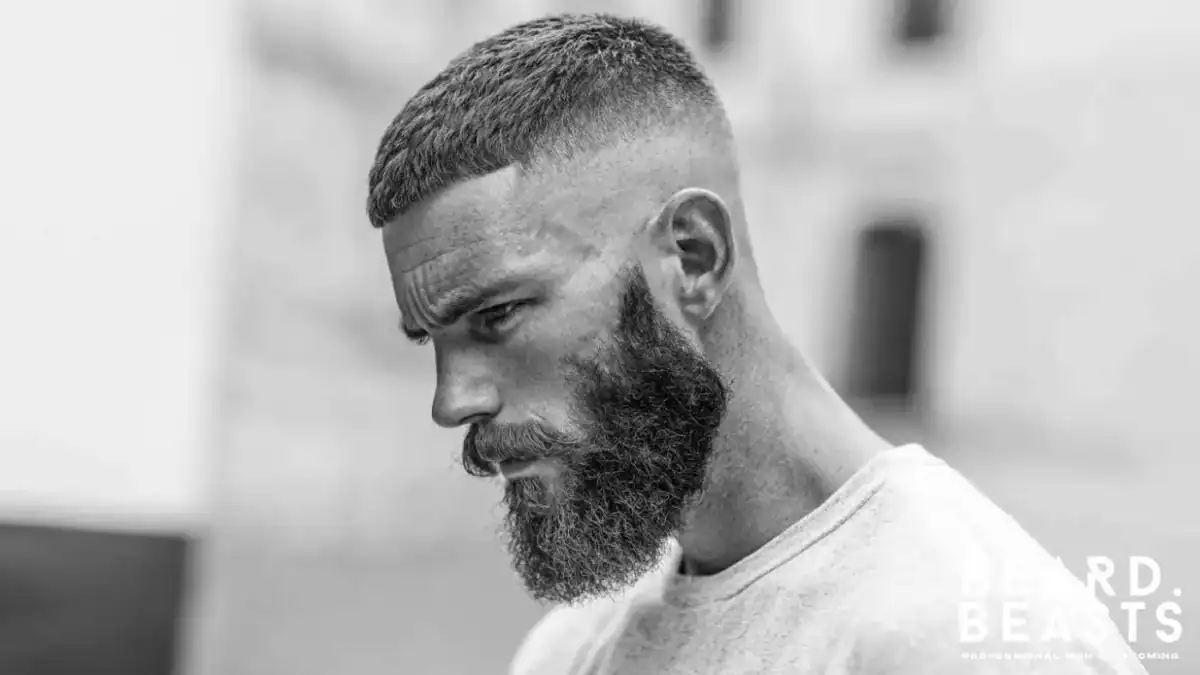The Garibaldi beard doesn’t whisper. It’s bold, unmistakably present, and commands attention without effort. You don’t grow this beard by accident—you commit to it.
It’s a look that signals you’ve moved beyond the neatly edged trims and are embracing something with weight, presence, and purpose. It’s rugged, deliberate, and stands out without trying.
In this guide, we’ll walk through how to grow a Garibaldi beard properly—from the long-game approach to shaping, maintaining, and carrying it with intent. The goal isn’t perfection. It’s power through presence.
Let’s get into it.
What Is a Garibaldi Beard?
If you want a beard that speaks before you do, the Garibaldi delivers. Named after Giuseppe Garibaldi—a 19th-century Italian general who unified Italy and wore a commanding beard—the style is as bold as its namesake.
The Garibaldi is defined by its thick, rounded shape and natural finish. It typically grows to 6 to 8 inches in length (15–20 cm), delivering volume that feels bold yet controlled.
There’s no sharp point or aggressive taper. The base stays round and full, creating a look that projects masculinity without exaggeration. The mustache blends in—styled just enough to match the beard’s intent, not distract from it.
This isn’t a style for indecision. The Garibaldi requires patience, presence, and a willingness to grow with purpose.
Garibaldi Beard Style Examples
The Garibaldi may follow a structure, but that doesn’t mean it looks the same on everyone. These variations prove you can stay within the silhouette—and still make it your own.
Classic Garibaldi with Full Volume
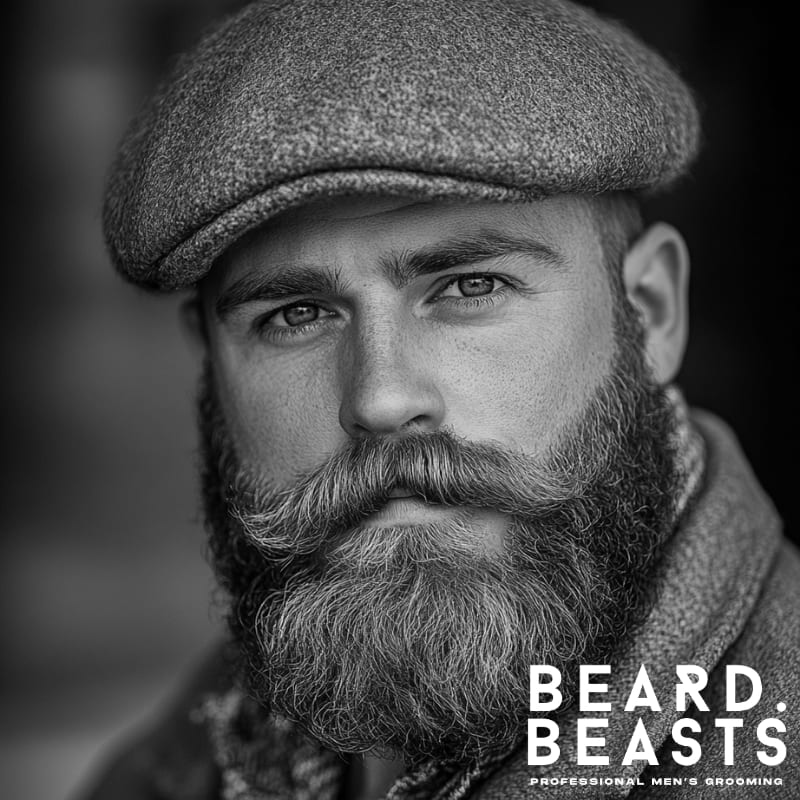
This is the Garibaldi in its purest form—dense, rounded, and left to grow with minimal interference. The cheeks are full, the neckline is clean, and the natural curve frames the jaw with understated strength.
Brushed-Back Hair, Structured Beard
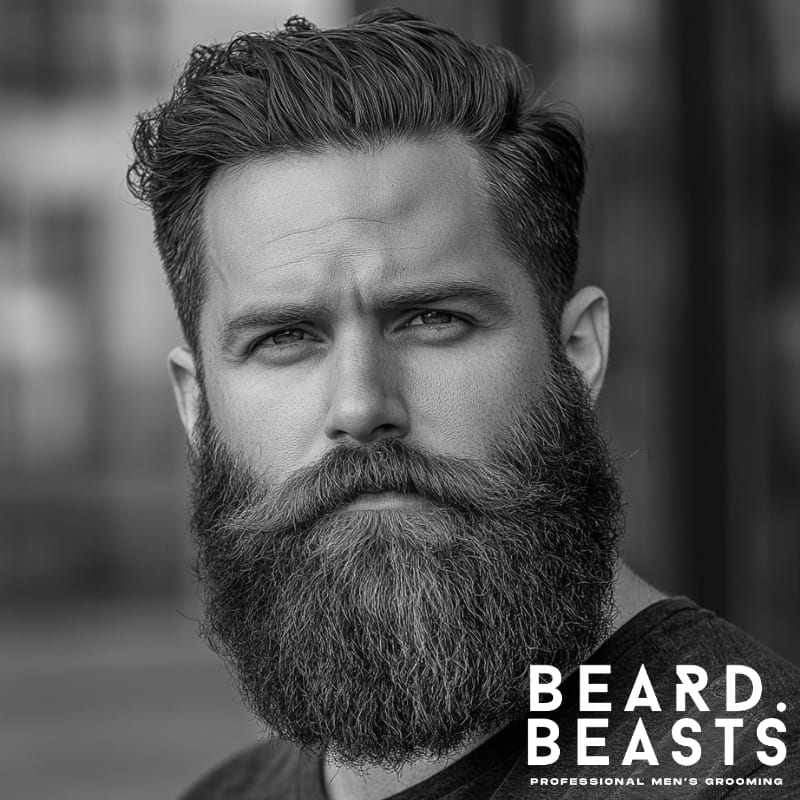
A neatly styled top adds contrast to the beard’s weight, balancing refinement with rugged edge. The result is deliberate, cohesive, and styled to strike balance and control.
The Laid-Back Lumberjack
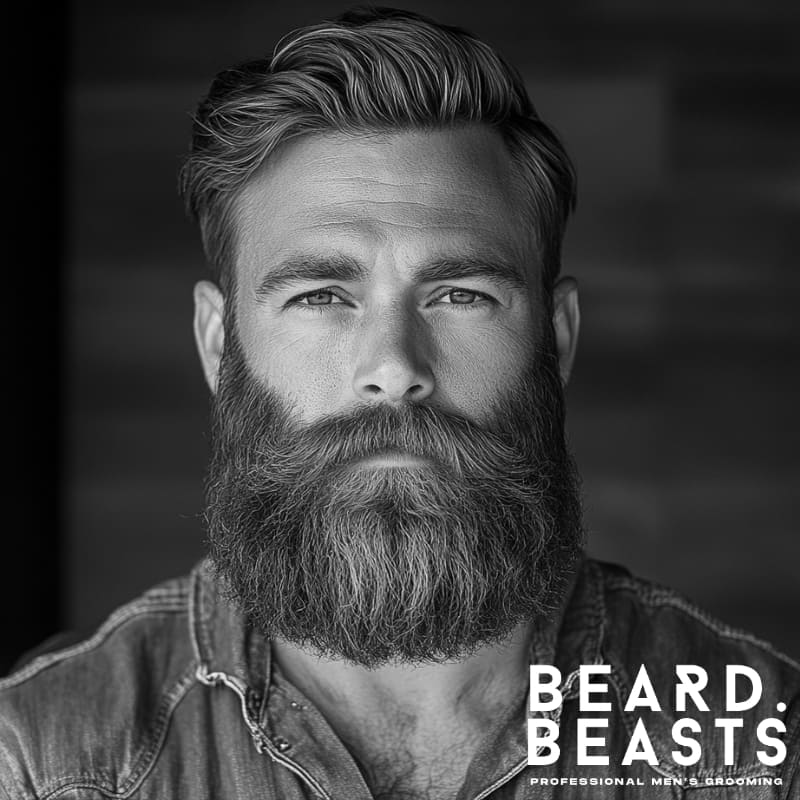
Texture and volume take center stage, with soft waves and a rounded base creating a relaxed yet powerful look. No taper, no harsh lines—just natural flow that carries weight.
Modern Twist with Slight Fade
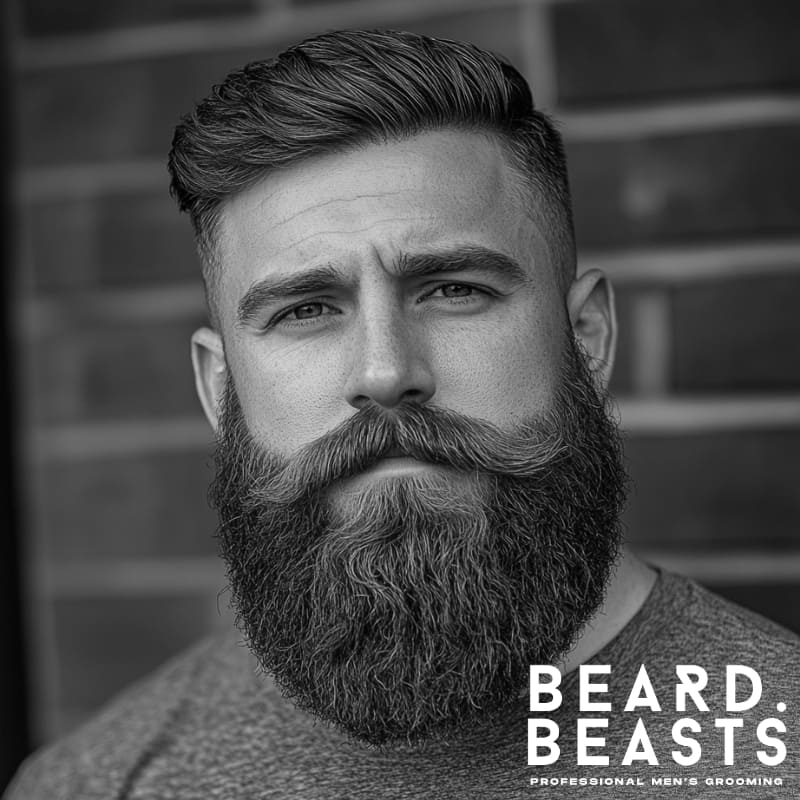
The fade around the ears keeps the silhouette intact while introducing a subtle update. The bulk remains, but the transition adds modern polish without disrupting the Garibaldi’s integrity.
Tattoos, Texture, and Beard Dominance
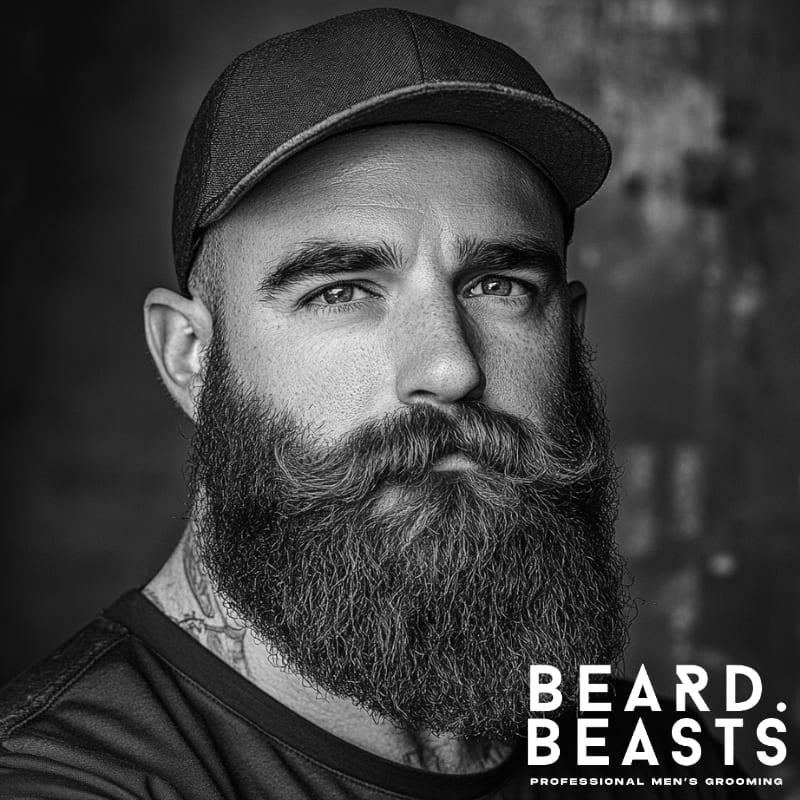
A fuller mustache and defined jawline meet dense growth and natural wave. It’s a style that leads with quiet confidence—no theatrics, just presence and intent.
Each variation proves the Garibaldi isn’t rigid—it’s adaptable. Whether you wear it clean and classic or with a modern edge, the strength lies in the volume, the silhouette, and the quiet confidence it commands.
How to Grow a Garibaldi Beard
A proper Garibaldi takes 12 to 16 months of growth—no shortcuts, no panic trims. It’s a slow build that rewards consistency over control.
Let it build across the jawline, cheeks, and especially beneath the chin—where the foundation takes shape.
Avoid shaping too early—tidy, but don’t interfere. Sharp lines and overcorrections work against the fullness you’re trying to achieve.
If flyaways get unruly, snip sparingly with scissors rather than reaching for clippers. It’s about guiding the beard, not managing it into place.
Brush daily to encourage a uniform growth direction and prevent matting. A boar bristle brush is ideal—it smooths without pulling or breaking the hair.
Apply beard oil from the early stages to keep the skin healthy and the hair soft. A hydrated beard grows better and looks stronger as it fills in.
Let the mustache come in alongside the beard—don’t isolate it. Trim just at the lip line, and let the sides connect naturally for cohesion.
Time and discipline shape a stronger beard than any blade. Let the beard develop at its own pace—and give it the space to become what it’s meant to be.
Why You Need to Look After Your Beard While It Grows
A Garibaldi beard doesn’t reach full form by neglect. Consistent grooming builds the foundation for shape, texture, and presence.
Wash 2–3 times per week with a beard wash to remove buildup without stripping natural oils.
Apply beard oil daily to soften coarse strands, prevent dryness, and promote healthier growth.
Brush with a boar bristle brush every morning to train direction, distribute oils, and reduce tangles.
Use beard balm as needed to tame puffiness and keep the shape neat as your beard gains length
Avoid over-trimming during early stages—focus on density before shaping.
Groom with the end result in mind—long before it takes shape. The effort you invest now determines how strong it looks later.
How to Shape a Garibaldi Beard
Shaping a Garibaldi is about refinement, not reinvention. Your job is to manage bulk without compromising fullness.
Let the base curve naturally under the jaw, forming a soft, rounded shape that defines the beard’s structure. Let go of sharp geometry—this beard was built to flow, not conform.
Use beard scissors to control shape with precision and subtlety. Clippers are best reserved for the neckline or light bulk adjustments around the cheeks.
Maintain a low neckline to preserve under-chin density—that’s the support system of the entire beard. Trimming too high removes the weight that makes this style work.
Clean the upper cheeks just enough to keep stray hairs in check. Follow your natural line and avoid aggressive reshaping.
Keep the mustache full and blended—trim only along the lip, never thinning the sides. It should flow seamlessly into the beard, not sit apart from it.
Take your time. With a Garibaldi, a steady hand and patience make more impact than aggressive styling.
How to Maintain a Garibaldi Beard
A strong Garibaldi doesn’t stay that way by accident. Regular upkeep protects the shape, texture, and presence you’ve worked to build.
Trim every two to three weeks to maintain balanced length and keep the base rounded. Avoid heavy shaping—use scissors to adjust growth and preserve volume.
Tidy the neckline just below the beard without cutting into the jaw. This keeps the foundation clean without compromising fullness.
Use beard oil daily to soften coarse strands, reduce irritation, and maintain a healthy shine. Apply when the beard is slightly damp for better absorption.
Brush with a boar bristle tool each morning to train growth and maintain order. It distributes oils and lifts the beard into its best shape.
If puffiness becomes an issue, work a small amount of beard balm through the beard to smooth and control. Avoid heavy products that weigh it down.
The Garibaldi should feel deliberate—but never forced. A light but consistent grooming routine keeps it powerful without losing its edge.
Garibaldi Beard FAQs
This beard makes a statement—but it also raises questions.
Before you commit to the boldness, clarity helps you grow, shape, and maintain it without second-guessing your every move.
How long is a Garibaldi beard?
Typically between 6 to 8 inches in length, which takes about 12 to 16 months of growth. It’s not a quick style—it’s a long-term investment in presence.
What’s the difference between a Garibaldi and a Bandholz?
The Garibaldi is shorter, rounder, and more structured. The Bandholz grows longer and looser, with no defined shape or trim.
Can I use clippers to shape a Garibaldi?
Yes, but only for light tidying on the neckline or cheeks. For the main shape, scissors offer better control and preserve the beard’s natural body.
Is the Garibaldi beard good for patchy growth?
Not ideal—it needs density across the cheeks and jaw to deliver its signature look. If your growth is uneven, build it up first before attempting this style.
What face shapes does the Garibaldi suit best?
It flatters oval, square, and rectangular faces by adding balance and strength. Round faces can wear it too—with careful shaping around the base and sides.
Do I need a mustache for a Garibaldi?
Absolutely. The mustache should be full and blend into the beard—thin or disconnected growth breaks the continuity of the look.
A Garibaldi isn’t built overnight—but once you understand the fundamentals, it’s far easier to wear with confidence.
Final Thoughts
The Garibaldi beard isn’t grown by accident—it’s earned over time. It demands patience, attention, and a steady refusal to rush the process.
From the first awkward weeks to the final rounded silhouette, it’s less about perfection and more about presence. You’re building something bold—but with restraint.
Keep your lines soft, your maintenance consistent, and your routine dialed in. The Garibaldi doesn’t aim to impress—it earns recognition through restraint.
Grow it fully. Shape it purposefully. And when it finally arrives, wear it with the quiet confidence that it was always yours to own.




